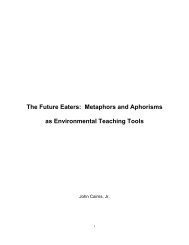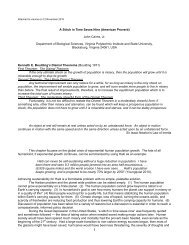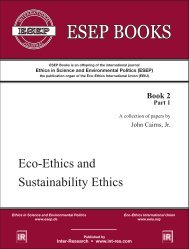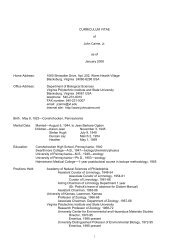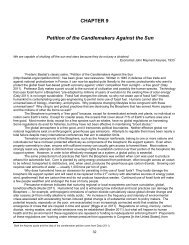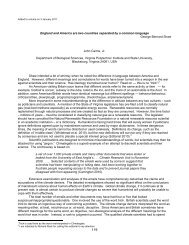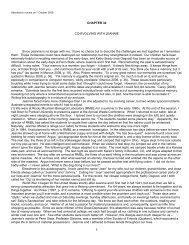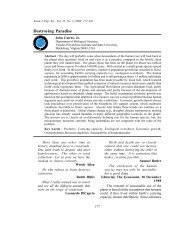View - ResearchGate
View - ResearchGate
View - ResearchGate
You also want an ePaper? Increase the reach of your titles
YUMPU automatically turns print PDFs into web optimized ePapers that Google loves.
Article 35289sequence, a particular resource, nectar, is partitioned because some species are more suited togathering nectar from certain flowers than others. Species diversity is maintained by conditions thatpermit the survival of substantial numbers of these co-evolutionary relationships. However, if aparticular species of hummingbird disappeared, the nectar would still be available to other nectargathering species less capable of exploiting the resources of a particular flower.Furthermore, evolution is always moving toward increasing complexity, which results in finer andfiner partitioning of resources. Complexity in nature results in an array of feedback loops, interrelationships,and, most important, use and reuse of resources. This dynamic system keeps everything(e.g. nutrients) moving, and species are also constantly being replaced in a successional process.However, species that disappear from one locale usually appear at another one. Despite this activity,the structure and function of the ecosystem remain remarkably stable, although the ecosystemdoes vary within limits. This dynamic stability is maintained by the interaction of an array of rateprocesses. One such interaction that results in an equilibrium number of species has beendescribed by MacArthur and Wilson (1963). Another model of community structure that remainsremarkably constant, although the kinds of species do not, is described by Patrick (1949). Illustrativefunctional attributes are described by Likens and Bormann (1995).Nature favours quantity, from which it selects quality. Individual species and individual organismshave important roles, always in the context of the interdependent web of life in which all species,including humans, are a part. Often overlooked in the quest for sustainability are the changesrequired in the direction of humankind’s financial investments, the orientation of its technology, theallocation of global resources, and, most important, in our mind set. Emulating the processes ofnature is the most direct path to sustainability.Nature ensures that its resource reserves are not readily available on demand. Furthermore, systematicrecycling and reuse protects nature’s inventory of both renewable and nonrenewableresources and keeps them from being pushed beyond critical limits needed for sustainable use.Societal and institutional change must be directed by the ability of natural systems to absorb theeffects of human activities. Humankind is ethically responsible for present unsustainable practicesand also for instituting the changes necessary to achieve sustainability.The concept of viewing natural systems as sacred and inviolate will be a shocking or offensiveidea to many people. Even acknowledging humankind’s dependence upon natural systems will bedifficult for many people. Asserting that both exponential and economic growth are unsustainableon a finite planet will be met by ridicule and sarcasm by those people reaping enormous wealthfrom these practices. However, if humankind lacks the courage and depth of ecological understandingnecessary to eliminate unsustainable practices, nature will do so in ways that will causeboth the wealthy and poor to suffer.Earth is an ecosphere and the evolutionary source and support of life. A committee of the EcologicalSociety of America defined an ecosystem as a spatially explicit unit of Earth that includes allorganisms, along with all components of the abiotic environment within its boundaries (Christensenet al. 1996). The term ecosystem was first used by Tansley (1935), who noted that organisms claimsociety’s primary interest. He also stated that, even when research and thinking are on the basiclevel, organisms cannot be separated from the special environment with which they form one physicalsystem. The National Research Council (1992) states that the goal of restoration is to emulatea natural, functioning, self-regulating (italics mine) system that is integrated into the landscape inwhich it occurs. It is almost platitudinous to state that a damaged ecosystem is not self regulatingand that exemplary ecological restorations have restoring this capability as a major goal. During the



